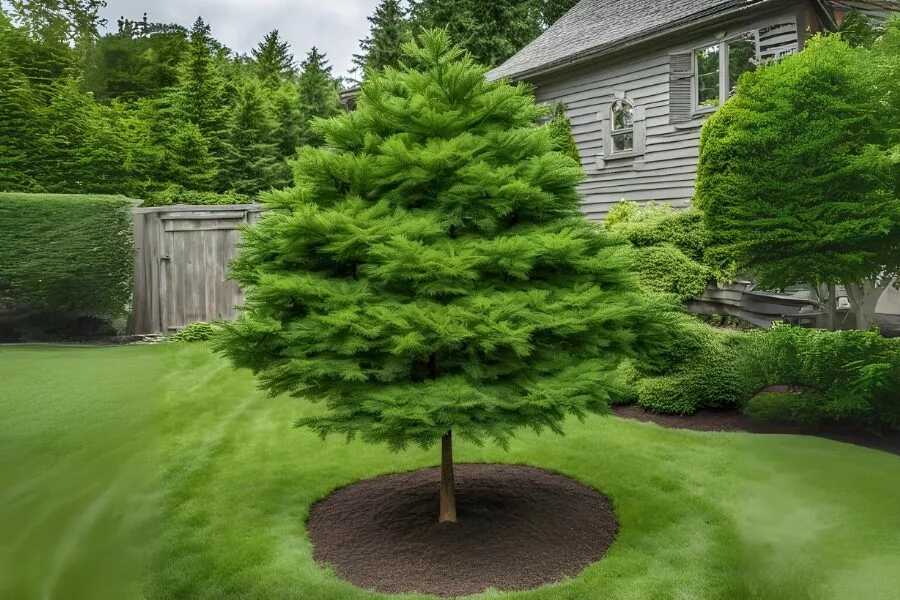Hemlock trees, though often overshadowed by their more illustrious counterparts like pines, oaks, and maples, have a unique charm. They also come with their ecological benefits that make them worthy of recognition. And, what are those benefits? We’ll share them with you in just a bit. Hemlock trees can be mistaken for pines sometimes, but while pines are celebrated for their tall, straight trunks and oaks for their grand, sprawling canopies, hemlocks offer their own distinctive allure.
In this article, we’ll tell you all you need to know about hemlock trees. We’ll explore their distinctive characteristics, the differences between Eastern and Western species, and their environmental contributions. So, if you’re considering adding a hemlock to your garden or looking to support conservation efforts, you can consider yourself an expert by the end of this article!
Understanding these remarkable trees will highlight why they deserve both our admiration and protection. They are indispensable elements of a thriving, balanced ecosystem.
What Are Hemlock Trees?
Hemlock trees have a beautiful evergreen foliage, with its delicate, needle-like leaves and graceful, pendulous branches, provides a striking contrast to the more rugged forms of other conifers. This aesthetic appeal makes them a gorgeous backdrop as well as a grand focal point in any landscape.
Now, where are hemlock trees found?
Hemlocks are found across North America, from the lush, temperate rainforests of the Pacific Northwest to the cool, shaded forests of the eastern United States and Canada. This wide distribution highlights their adaptability and resilience.
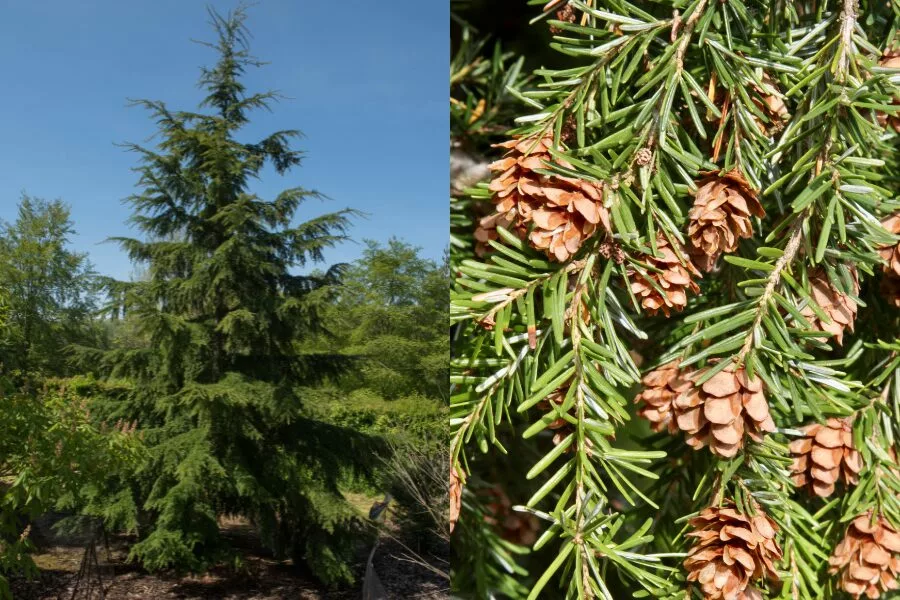
Beyond their visual impact, hemlock trees also play an important role in the ecosystems. They thrive in a variety of soil types and climatic conditions, from the moist, acidic soils of their native regions to the challenging environments where few other trees can survive. Their deep, fibrous root systems help stabilize the soil, preventing erosion and supporting the health of the forest floor. The dense canopy they create offers essential shelter and nesting sites for a variety of wildlife, including birds, insects, and mammals.
Adding to their ecological roles, hemlocks have practical uses. Their wood holds a lot of value as it is both strong and durable, making it a sought-after resource for construction and craftsmanship. What’s more: these trees contribute to the health of waterways too! They help by filtering rainwater and maintaining stream temperatures, which supports aquatic life.
The Hemlock Species: Eastern vs. Western
Hemlock trees are divided primarily into two distinct species: the Eastern Hemlock (also known as the hemlock scientific name, Tsuga canadensis) and the Western Hemlock (also known as the hemlock scientific name, Tsuga heterophylla).
Each species of the Tsuga tree boasts unique characteristics and plays a vital role in its respective environment.
Eastern Hemlock (Tsuga Canadensis)
Native to the northeastern United States and eastern Canada, the Eastern Hemlock tree, or the Tsuga canadensis (the Eastern Hemlock scientific name), is a symbol of the ancient forests of the region.
This Tsuga tree is distinguished by its delicate, drooping branches that create a lush, feathery appearance. Its small, flat needles are a soft green on top and a silvery underside, giving the tree a gentle, shimmering quality in the wind.
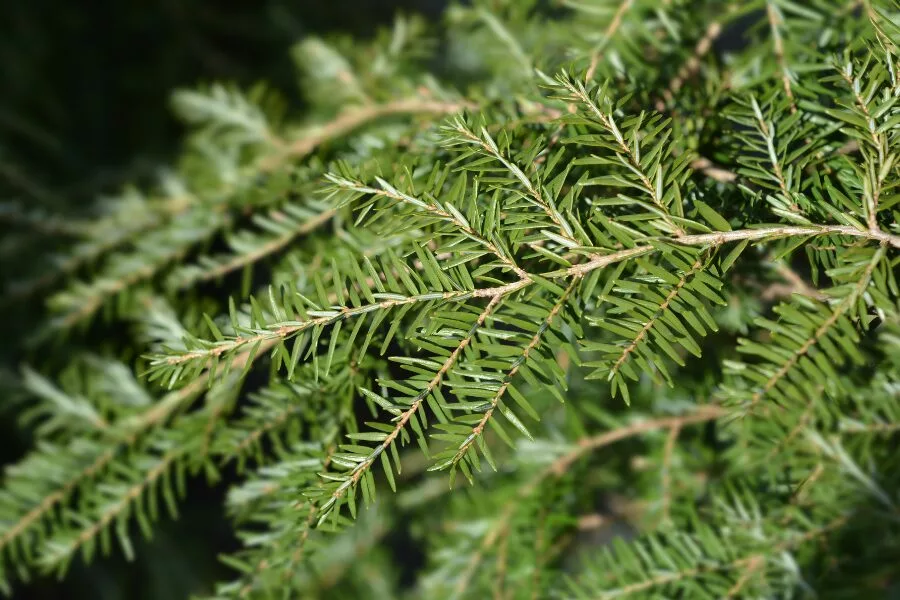
The Eastern Hemlock thrives in shaded, cool environments, often found in moist, forested areas that receive little direct sunlight. It is well-suited to the acidic, well-drained soils of these regions.
The Eastern Hemlock height can go up to 70 feet, though it generally maintains a more modest stature in densely packed forests. That’s a moderate Eastern Hemlock growth rate. Its bark is smooth and reddish-brown, with a rich, warm tone that deepens with age.
The Eastern Hemlock tree is not just visually striking; its dense foliage provides essential cover for various species of birds and small mammals, making this Tsuga tree a critical component of its forest ecosystem.
Western Hemlock (Tsuga Heterophylla)
The Western Hemlock tree, on the other hand, is native to the Pacific Northwest, with its range extending from the coastal regions of Alaska down to northern California.
This Tsuga tree species is more adaptable to a range of soil types and climatic conditions compared to its eastern counterpart. Its canopy is more open and airy, allowing light to filter through and support a diverse understory of plants and fungi.
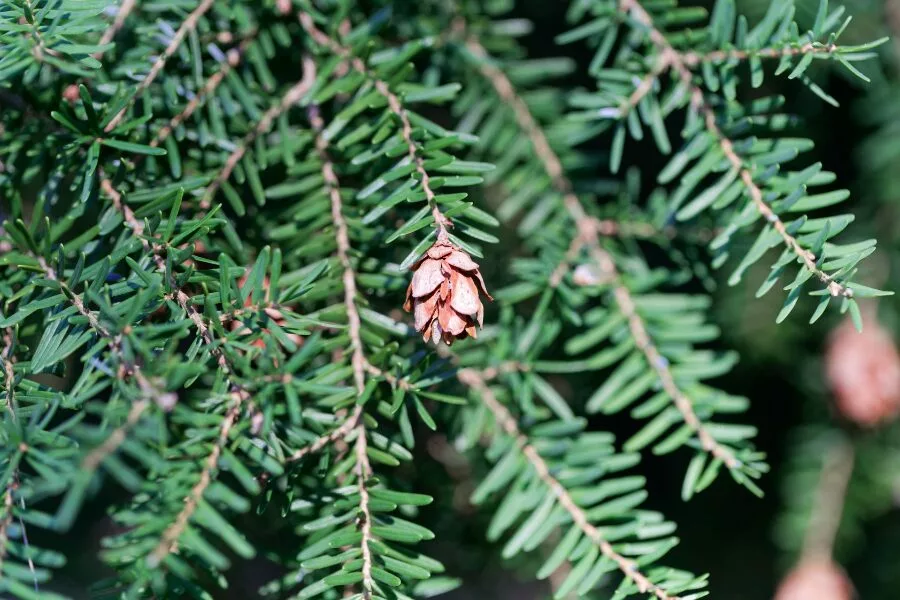
Western Hemlocks are characterized by their slightly longer needles, which have a more varied texture and color than those of the Eastern Hemlock tree. The needles are typically dark green on top and pale underneath.
This species, unlike the Eastern Hemlock growth rate, can grow to impressive heights, reaching up to 200 feet, making it one of the tallest conifers in North America! Its bark is distinctive, often peeling away in thin strips, giving the tree a textured, layered appearance.
The Western Hemlock tree’s expansive canopy, varying from the Eastern Hemlock size, and robust root system play a crucial role in supporting the complex web of life in its forest habitat.
Ecological Importance of Hemlock Trees
The importance of hemlocks are integral to the ecosystems they inhabit, serving multiple ecological functions. Their dense foliage offers vital habitat and shelter for a variety of wildlife, including birds, insects, and small mammals. The shelter provided by hemlocks can be crucial for species that rely on a dense canopy for nesting and protection from predators.
In addition to providing habitat, hemlocks play a significant role in maintaining soil health. Their extensive root systems help stabilize soil, reducing erosion and promoting the formation of healthy forest floors. This stabilization is especially important in preventing landslides and protecting water quality in nearby streams and rivers.
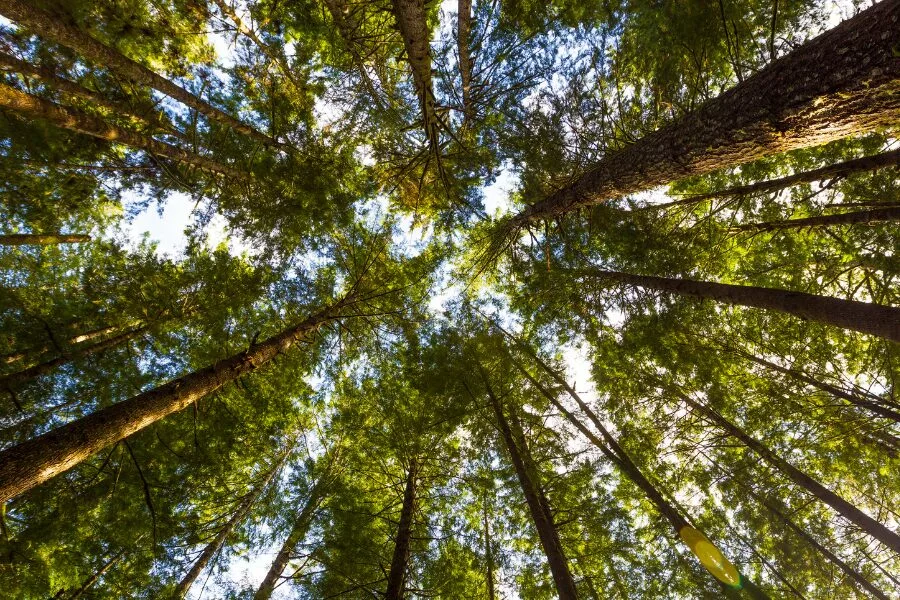
Hemlocks also contribute to water regulation in their ecosystems. The trees help filter rainwater, reducing sediment and pollutants that can enter waterways. By moderating stream temperatures with their shade, hemlocks support the health of aquatic life, including fish species that depend on cold, clean water.
Overall, hemlocks are a cornerstone of their natural habitats. They support biodiversity, contribute to soil and water conservation, and play a crucial role in maintaining the balance of their ecosystems. Aren’t they amazing? Understanding their ecological significance will help us realize there’s more to their visual appeal, and remind us all about the need for their protection and conservation.
Why You Should Plant Hemlock Trees in Your Garden
Integrating hemlock trees into your garden can offer a range of benefits, from aesthetic enhancement to environmental impact. Here’s why you should consider adding these remarkable trees to your landscape:
Aesthetic Appeal
Hemlocks bring a unique charm to any garden with their elegant, soft, feathery needles and distinctive shape. Their graceful form creates a serene and tranquil atmosphere, making them a beautiful focal point or backdrop in your garden. The evergreen foliage of hemlocks maintains its vibrant green color throughout the year, ensuring that your garden retains visual interest even in the winter months. The cascading branches of the hemlock can add a touch of softness and movement to your garden’s design, enhancing the overall aesthetic with their delicate texture and subtle beauty.
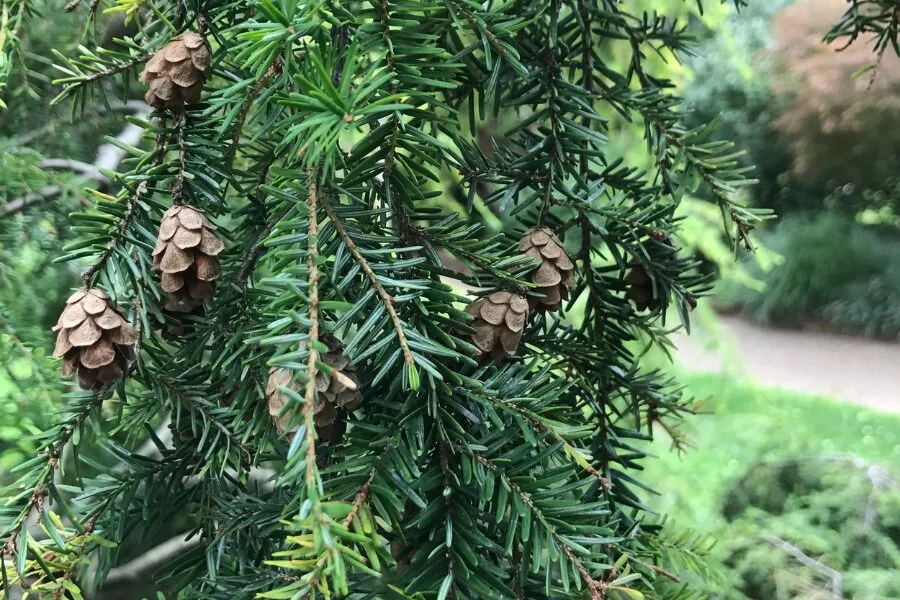
Low Maintenance
Once established, hemlock trees are relatively low maintenance, making them a practical choice for gardeners looking for hassle-free greenery. They are known for their resilience and can thrive in a variety of soil conditions, though they prefer well-drained, acidic soils. Hemlocks are generally resistant to pests and diseases, reducing the need for frequent interventions. Additionally, their slow growth rate means that they require less frequent pruning compared to faster-growing trees, saving you time and effort in garden upkeep. Their adaptability and hardy nature make them a reliable addition to your landscape.

Environmental Benefits
Beyond their beauty and low maintenance, hemlock trees offer significant environmental advantages that we’re big fans of:
- Carbon Sequestration: Hemlocks are effective at capturing and storing carbon dioxide from the atmosphere. This process helps mitigate the effects of climate change by reducing greenhouse gasses.
- Air Quality Improvement: By absorbing pollutants and releasing oxygen, hemlocks contribute to cleaner, healthier air in your garden and the surrounding environment.
- Wildlife Habitat: Hemlocks provide valuable habitat for a range of local wildlife, including birds, insects, and small mammals, thanks to the Eastern Hemlock size. The dense foliage offers shelter and nesting sites, supporting biodiversity.
- Soil Erosion Reduction: The extensive root systems of hemlocks help stabilize soil, preventing erosion and promoting the formation of healthy, resilient soil structures.
- Water Conservation: Hemlocks play a role in conserving water by reducing runoff and helping to maintain moisture levels in the soil. Their presence can also help regulate the temperature of nearby water sources, supporting aquatic ecosystems.
By adding a few hemlock trees to your garden, you can boost its aesthetic appeal while contributing to environment. How amazing is that? These trees are a great combination of beauty, practicality, and ecological benefits and it’s safe to say they are an extremely valuable addition to any garden. You can create a peaceful retreat, reduce maintenance, and support local wildlife by planting hemlocks!
Toxicity and Safety Measures for Hemlock Trees
While hemlock trees offer numerous benefits and can greatly enhance your garden, it’s important to be aware of potential hazards before planting. Here’s what you should keep in mind to ensure a safe and successful addition of hemlocks to your landscape:
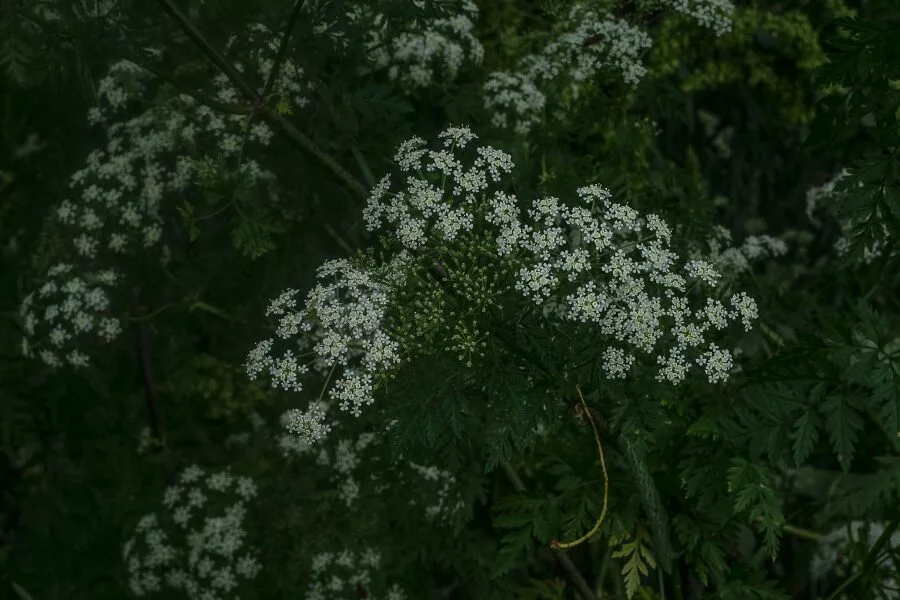
Poison Hemlock: A Different Species
It’s crucial to know how to identify hemlock trees used in landscaping and the Poison Hemlock (Conium maculatum), which is a completely different species. Poison Hemlock is notorious for its high toxicity to both humans and animals. This plant is not related to the Eastern and Western Hemlock trees (Tsuga spp.) but is often mistaken for them due to its similar name. So, be alert when it comes to hemlock tree identification!
Poison Hemlock is characterized by its white, umbrella-shaped flower clusters and fern-like foliage. It can be found in various habitats, including roadsides and disturbed areas. Contact with or ingestion of Poison Hemlock can cause severe health issues, including respiratory failure and death. Therefore, it’s vital to ensure that you are selecting the correct species of hemlock for your garden and not the toxic Poison Hemlock.
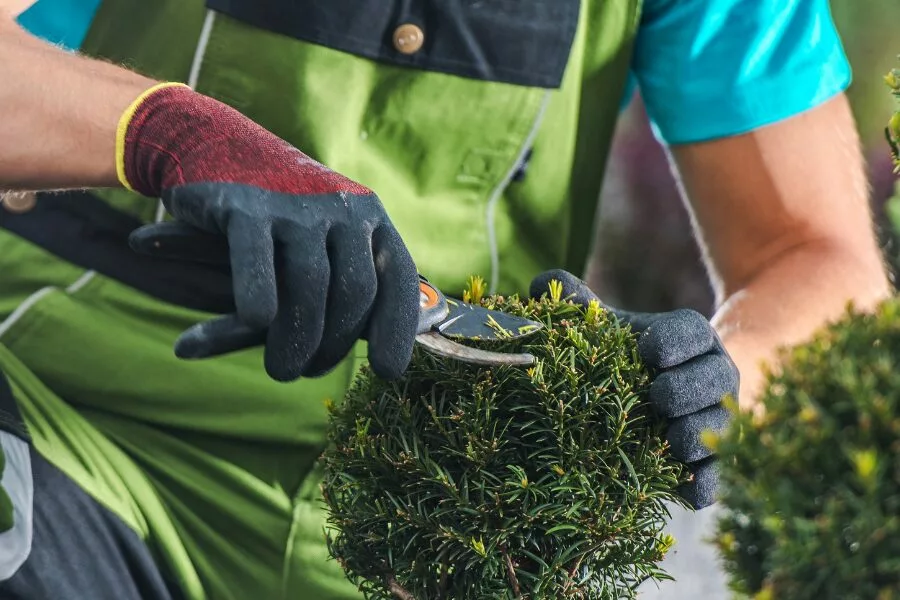
Safety Precautions
To minimize any risks associated with planting hemlocks and ensure a safe environment for everyone, including children and pets, consider these precautions:
- Verify Species: It’s important to know how to identify hemlock trees. Double-check the species of hemlock you are planting to confirm it is not the toxic Poison Hemlock. Purchase plants from reputable nurseries or suppliers who can provide accurate information about the species.
- Educate Yourself: Learn about the specific hemlock species you are introducing to your garden. Understand its characteristics, growth habits, and any potential risks associated with it. This knowledge will help you make informed decisions and manage the plant effectively.
- Monitor Growth: Keep an eye on the hemlocks as they grow. While the common hemlocks used in landscaping are generally safe, it’s good practice to monitor them for any unusual signs or issues.
- Teach Awareness: If you have children or pets, educate them about the plants in your garden. Ensure they understand not to touch or ingest any unfamiliar plants. Proper labeling and signage can also help remind everyone about the presence of hemlocks and their safety.
By taking these precautions, you can enjoy the beauty and benefits of hemlock trees while maintaining a safe environment for your family and pets. You can make the most of these remarkable trees, just be informed and stay cautious! This way, you can avoid potential hazards associated with the less benign relatives of these trees.
Summing Up!
Hemlock trees are more than just an attractive addition to your garden; they play a crucial role in our ecosystems by providing vital shelter and food for wildlife, while supporting healthy soil structures, and helping regulate local water cycles.
They also absorb carbon dioxide and improve air quality, actively contributing to mitigate climate change. They are also able to stabilize soil and reduce erosion, which makes them very essential for maintaining the health and stability of forested and garden landscapes.
So, is the hemlock tree extinct? Of course not. And we’d like to keep it that way. If you’re inspired to add hemlocks to your garden or support their conservation, Ecowiser is here to help! We offer a range of eco-friendly products and resources designed to assist you in making sustainable choices.
Visit our website to explore our full range of eco-friendly products and learn more about how you can contribute to a sustainable future. Discover gardening tips, conservation resources, and opportunities to get involved in protecting hemlock trees.
Frequently Asked Questions
Are Eastern and Western Hemlocks the same species, and where are hemlock trees found?
No, Eastern and Western Hemlocks are distinct species with different characteristics and growing conditions. Eastern Hemlock trees, also known as, Tsuga canadensis (Eastern Hemlock scientific name) are found in the eastern U.S. and Canada with a varying Eastern Hemlock height, while Western Hemlock trees are native to the Pacific Northwest.
Can I plant a hemlock tree in my garden?
Yes, hemlocks are suitable for many gardens, provided you choose the right species for your climate and soil. They are hardy, low-maintenance trees that can enhance the beauty and ecological health of your garden.
Is hemlock tree poisonous?
Most hemlock species used in landscaping are not toxic. However, it’s important to practice hemlock tree identification and distinguish between these and the Poison Hemlock (Conium maculatum), which is highly toxic. If you’re wondering, “Is hemlock tree poisonous?”, then make sure to verify the species before planting.
How can I contribute to hemlock conservation?
Support hemlock conservation by choosing sustainably sourced products, participating in local conservation initiatives, and spreading awareness about the importance of hemlocks. This way you’ll never have to worry if the hemlock tree extinct.
